Park City 2035: Analysis of Policy-Driven Urban Expansion and Heat Island Effects Under Scenario Simulation
Abstract
1. Introduction
2. Materials and Methods
2.1. Study Area: Tianfu New District
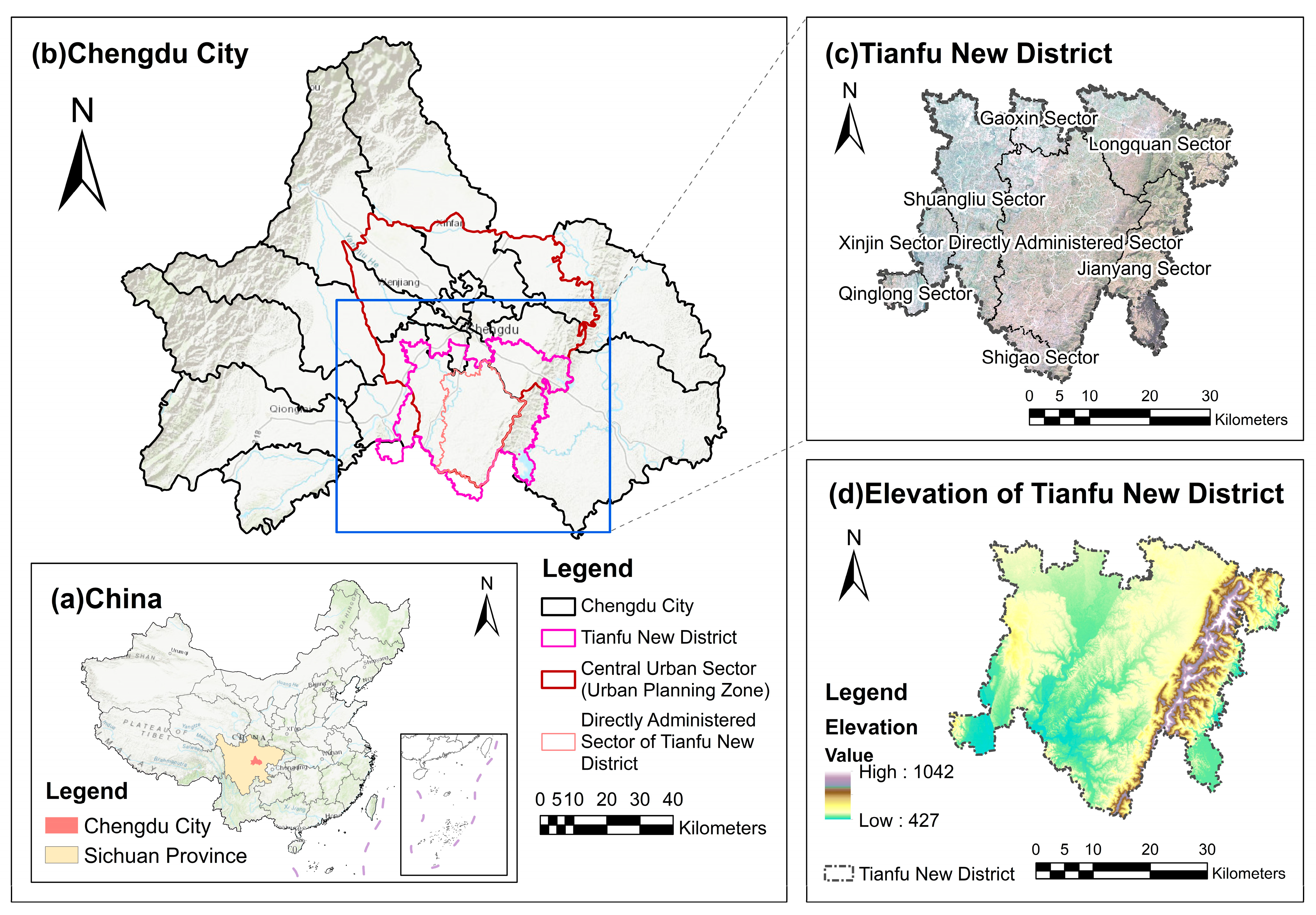
2.2. Data and Methods
2.2.1. A General Overview of the Study
2.2.2. Land Use Mapping and Classification
2.2.3. Multi-Scenario Simulation of Land Use Conflicts
- (1)
- Natural Development Scenario (ND): This scenario is based on land use changes from 2000 to 2024, considering both natural and socio-economic factors. This scenario does not consider constraints such as policies, regulations, land use planning, or urban development plans. The future land demand for 2035 is projected using linear regression and used as the land demand parameter in the PLUS model. This scenario assumes that the spatial pattern of land use in Tianfu New District will evolve linearly based on its historical trajectory, representing a theoretical development model. This scenario serves as the foundation for the other scenarios.
- (2)
- Economic Development Scenario (ED): In 2014, Tianfu New District was designated as a national-level district. As a key node in the “Belt and Road” initiative and economic development, urbanization and industrialization have progressed rapidly. With a solid industrial base, key development zones, such as Tianfu Headquarters Business District, Chengdu Science City, and Tianfu Digital Cultural City, have attracted numerous enterprises. Prioritizing economic development amid rapid urbanization and industrialization necessitates extensive built-up land to support large-scale spatial development and industrial construction. In this scenario, based on the ND, the likelihood of built-up land transitioning to cropland, water bodies, forest land, grassland, and bare land decreases by 40%, while the probability of cropland, forest land, grassland, water bodies, and bare land transitioning to built-up land increases by 40%, 10%, 20%, 10%, and 50%, respectively.
- (3)
- Sustainable Development Scenario (SD): In 2019, Tianfu New District’s ecological network became a key component of Chengdu’s ecological network. According to the “Chengdu Master Plan (2016–2035)”, ecological corridors and biodiversity protection networks based on the Longquan Mountain Ecological Zone must be established, and ecological conservation and restoration efforts in the Ring Ecological Zone and Xinglong Lake areas must be strengthened. This scenario builds upon the ND by incorporating nature reserves from the regional ecological security map as restricted conversion zones. The probability of forest land and grassland converting to built-up land decreases by 20%, and the probability of water bodies converting to built-up land decreases by 40%, while the probability of water bodies transitioning to cropland increases by 30%. Additionally, the probability of cropland converting to built-up land decreases by 30%, and the probability of bare land transitioning to built-up land increases by 40%. The likelihood of built-up land transitioning to grassland increases by 10%, simulating a land use pattern that balances ecological protection and economic development.
- (4)
- Cropland Protection Scenario (CLP): Tianfu New District is one of Chengdu’s primary grain production bases, and protecting cropland in this area is essential for ensuring food security. According to the “Implementation Plan for Establishing a Higher-Level Tianfu Granary in the Chengdu Area” issued in August 2022, the plan aims to establish high-standard cropland. In this scenario, the focus is on stabilizing and protecting high-quality cropland in Tianfu New District. The cropland data from 2014, 2019, and 2024 were overlaid, and the areas consistently classified as cropland in all three years were designated as long-term stable cropland. Additionally, cropland with a slope of less than 6° was designated as high-quality cropland, and the stable and high-quality cropland areas were combined as restricted conversion zones [65]. Based on the SD, the linear regression transition probability matrix was adjusted. The probability of cropland converting to built-up land decreases by 70% [68,69], and the probability of cropland transitioning to grassland and water bodies decreases by 40%. Meanwhile, the probability of bare land transitioning to cropland increases by 50%, strictly enforcing cropland protection policies.
2.2.4. Quantification of Cooling Capacity
| Land Use Type | Shade | Kc | Albedo | Green Space |
|---|---|---|---|---|
| Bare Land | 0 | 0.7 | 0.25 | 0 |
| Built-up Land | 0.18 | 0.1 | 0.2 | 0 |
| Cropland | 1 | 0.75 | 0.18 | 1 |
| Forest Land | 1 | 1 | 0.2 | 1 |
| Grassland | 1 | 0.95 | 0.16 | 1 |
3. Results
3.1. Land Use Change Analysis (2000–2024)
3.2. Land Use Patterns Under Multi-Scenario Simulation
- 1.
- Natural Development Scenario (ND)
- 2.
- Economic Development Scenario (ED)
- 3.
- Sustainable Development Scenario (SD)
- 4.
- Cropland Protection Scenario (CLP)
3.3. Heat Mitigation Scenario Simulation
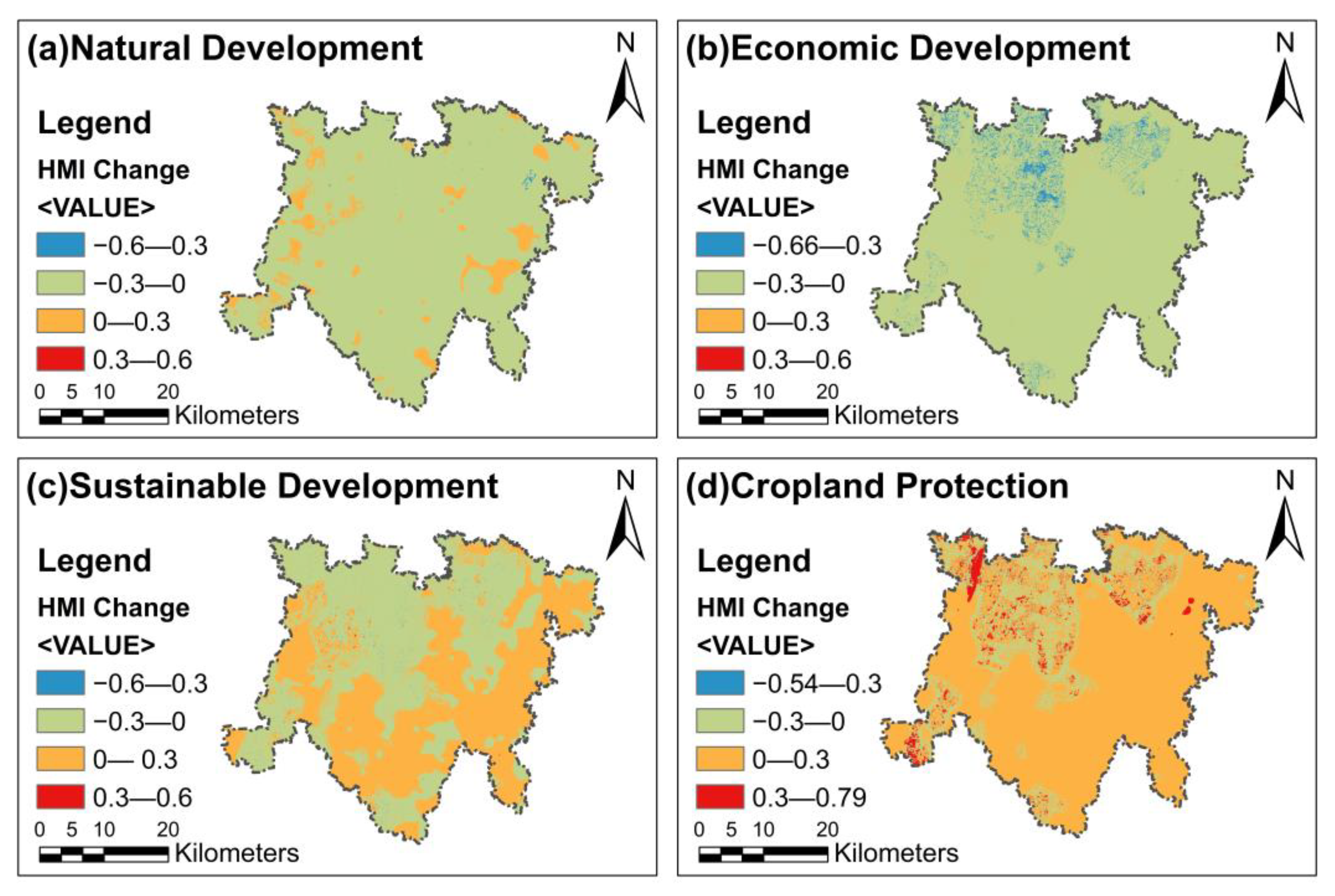
4. Discussion
4.1. Policy-Driven Land Use Changes and Cooling Benefits
4.2. Challenges in Policy Implementation and Optimization Directions
5. Conclusions
Author Contributions
Funding
Data Availability Statement
Acknowledgments
Conflicts of Interest
References
- Simonds, J.O. Landscape Architecture: A Manual of Site Planning and Design; McGraw-Hill Professional: New York, NY, USA, 2007. [Google Scholar]
- Almulhim, A.I.; Bibri, S.E.; Sharifi, A.; Ahmad, S.; Almatar, K.M. Emerging Trends and Knowledge Structures of Urbanization and Environmental Sustainability: A Regional Perspective. Sustainability 2022, 14, 13195. [Google Scholar] [CrossRef]
- United Nations. World Urbanization Prospects—Population Division—United Nations. Available online: https://population.un.org/wup/ (accessed on 4 December 2024).
- United Nations. World Urbanization Prospects: The 2014 Revision; Department of Economic and Social Affairs, Population Division: New York, NY, USA, 2015; p. 1. [Google Scholar]
- Dodman, D.; Hayward, B.; Pelling, M.; Broto, V.C.; Chow, W.; Chu, E.; Dawson, R.; Khirfan, L.; McPhearson, T.; Prakash, A.; et al. IPCC AR6 WGII Chapter 6: Cities, Settlements and Key Infrastructure. In Climate Change 2022: Impacts, Adaptation, and Vulnerability. Contribution of Working Group II to the Sixth Assessment Report of the Intergovernmental Panel on Climate Change; Cambridge University Press: Cambridge, UK, 2022. [Google Scholar]
- Pelling, M.; Garschagen, M. Put equity first in climate adaptation. Nature 2019, 569, 327–329. [Google Scholar] [CrossRef] [PubMed]
- Zhou, X.F.; Chen, H. Impact of Urbanization-Related Land Use Land Cover Changes and Urban Morphology Changes on the Urban Heat Island Phenomenon. Sci. Total Environ. 2018, 635, 1467–1476. [Google Scholar] [CrossRef] [PubMed]
- Ventriglio, A.; Torales, J.; Castaldelli-Maia, J.M.; Berardis, D.D.; Bhugra, D. Urbanization and Emerging Mental Health Issues. CNS Spectr. 2021, 26, 43–50. [Google Scholar] [CrossRef]
- Wu, J.; Xiang, W.-N.; Zhao, J. Urban Ecology in China: Historical Developments and Future Directions. Landsc. Urban Plan. 2014, 125, 222–233. [Google Scholar] [CrossRef]
- Li, G.; Zhang, X.; Mirzaei, P.A.; Zhang, J.; Zhao, Z. Urban Heat Island Effect of a Typical Valley City in China: Responds to the Global Warming and Rapid Urbanization. Sustain. Cities Soc. 2018, 38, 736–745. [Google Scholar] [CrossRef]
- Amani-Beni, M.; Zhang, B.; Xie, G.; Xu, J. Impact of urban park’s tree, grass and waterbody on microclimate in hot summer days: A case study of Olympic Park in Beijing, China. Urban For. Urban Green. 2018, 32, 1–6. [Google Scholar] [CrossRef]
- Bowler, D.E.; Buyung-Ali, L.; Knight, T.M.; Pullin, A.S. Urban greening to cool towns and cities: A systematic review of the empirical evidence. Landsc. Urban Plan. 2010, 97, 147–155. [Google Scholar] [CrossRef]
- Hu, Y.; Wang, C.; Li, J. Assessment of Heat Mitigation Services Provided by Blue and Green Spaces: An Application of the InVEST Urban Cooling Model with Scenario Analysis in Wuhan, China. Land 2023, 12, 963. [Google Scholar] [CrossRef]
- Zhao, C.; Fu, G.; Liu, X.; Fu, F. Urban planning indicators, morphology and climate indicators: A case study for a north-south transect of Beijing, China. Build. Environ. 2011, 46, 1174–1183. [Google Scholar] [CrossRef]
- Ouyang, Z.; Zheng, H.; Xiao, Y.; Polasky, S.; Liu, J.; Xu, W.; Wang, Q.; Zhang, Y.; Rao, E.; Jiang, L.; et al. Improvements in ecosystem services from investments in natural capital. Science 2016, 352, 1455–1459. [Google Scholar] [CrossRef]
- Peng, X.; Liao, L.; Tan, X.; Yu, R.; Zhang, K. City Health Assessment: Urbanization and Eco-Environment Dynamics Using Coupling Coordination Analysis and FLUS Model—A Case Study of the Pearl River Delta Urban Agglomeration. Land 2025, 14, 46. [Google Scholar] [CrossRef]
- Tao, Y.; Li, F.; Crittenden, J.; Lu, Z.; Ou, W.; Song, Y. Measuring urban environmental sustainability performance in China: A multi-scale comparison among different cities, urban clusters, and geographic regions. Cities 2019, 94, 200–210. [Google Scholar] [CrossRef]
- Mao, D.; He, X.; Wang, Z.; Tian, Y.; Xiang, H.; Yu, H.; Man, W.; Jia, M.; Ren, C.; Zheng, H. Diverse policies leading to contrasting impacts on land cover and ecosystem services in Northeast China. J. Clean. Prod. 2019, 240, 117961. [Google Scholar] [CrossRef]
- Chen, K.; Luo, Y.; Zhuo, L. The Spatial and Temporal Variation of Land Use in Dianchi Basin Under the Policy Driven by Urban Establishment Up at Mountain. In Proceedings of the 2018 26th International Conference on Geoinformatics, Kunming, China, 28–30 June 2018. [Google Scholar]
- Four Perspectives for Rural Areas in the European Community. Available online: https://english.wrr.nl/publications/reports/1992/06/09/ground-for-choices (accessed on 4 December 2024).
- Rounsevell, M.; Ewert, F.; Reginster, I.; Leemans, R.; Carter, T. Future scenarios of European agricultural land use: II. Projecting changes in cropland and grassland. Agric. Ecosyst. Environ. 2005, 107, 117–135. [Google Scholar] [CrossRef]
- Schulp, C.; Nabuurs, G.; Verburg, P. Future carbon sequestration in Europe—Effects of land use change. Agric. Ecosyst. Environ. 2008, 127, 251–264. [Google Scholar] [CrossRef]
- Metzger, M.; Schröter, D.; Leemans, R.; Cramer, W. A spatially explicit and quantitative vulnerability assessment of ecosystem service change in Europe. Reg. Environ. Chang. 2008, 8, 91–107. [Google Scholar] [CrossRef]
- He, C.; Liu, Z.; Tian, J.; Ma, Q. Urban expansion dynamics and natural habitat loss in China: A multiscale landscape perspective. Glob. Chang. Biol. 2014, 20, 2886–2902. [Google Scholar] [CrossRef]
- Tertre, A.; Lefranc, A.; Eilstein, D.; Declercq, C.; Medina, S.; Blanchard, M.; Chardon, B.; Fabre, P.; Filleul, L.; Jusot, J.; et al. Impact of the 2003 heatwave on all-cause mortality in 9 French cities. Epidemiology 2005, 17, 75–79. [Google Scholar] [CrossRef]
- Mitchell, D.; Heaviside, C.; Vardoulakis, S.; Huntingford, C.; Masato, G.; Guillod, B.; Frumhoff, P.; Bowery, A.; Wallom, D.; Allen, M. Attributing human mortality during extreme heat waves to anthropogenic climate change. Environ. Res. Lett. 2016, 11, 74006. [Google Scholar] [CrossRef]
- Wilby, R.L. Past and projected trends in London’s urban heat island. Weather 2003, 58, 251–260. [Google Scholar] [CrossRef]
- Smith, C.; Webb, A.; Levermore, G.; Lindley, S.; Beswick, K. Fine-scale spatial temperature patterns across a UK conurbation. Clim. Chang. 2011, 109, 269–286. [Google Scholar] [CrossRef]
- Heaviside, C.; Cai, X.; Vardoulakis, S. The effects of horizontal advection on the urban heat island in Birmingham and the West Midlands, United Kingdom during a heatwave. Q. J. R. Meteorol. Soc. 2015, 141, 1429–1441. [Google Scholar] [CrossRef]
- Sarfo, I.; Bi, S.; Xu, X.; Yeboah, E.; Kwang, C.; Batame, M.; Addai, F.K.; Adamu, U.W.; Appea, E.A.; Djan, M.A.; et al. Planning for cooler cities in Ghana: Contribution of green infrastructure to urban heat mitigation in Kumasi Metropolis. Land Use Policy 2023, 133, 106842. [Google Scholar] [CrossRef]
- Yang, Y. A Tale of Two Cities: Physical Form and Neighborhood Satisfaction in Metropolitan Portland and Charlotte. J. Am. Plan. Assoc. 2008, 74, 307–323. [Google Scholar] [CrossRef]
- Laidley, T. Measuring Sprawl: A New Index, Recent Trends, and Future Research. Urban Aff. Rev. 2016, 52, 66–97. [Google Scholar] [CrossRef]
- Kremer, P.; Hamstead, Z.; McPhearson, T. The value of urban ecosystem services in New York City: A spatially explicit multicriteria analysis of landscape scale valuation scenarios. Environ. Sci. Policy 2016, 62, 57–68. [Google Scholar] [CrossRef]
- Nj, N.; Alcamo, J.; Davis, G.; Vries, B.; Fenhann, J.; Gaffin, S.; Gregory, K.; Grubler, A.; Jung, T.Y.; Kram, T.; et al. IPCC Special Report on Emissions Scenarios; Cambridge University Press: Cambridge, UK, 2000. [Google Scholar]
- Sung, H. Land use change prediction of Cheongju using SLEUTH Model. J. Environ. Impact Assess. 2013, 22, 109–116. [Google Scholar]
- Arshad, S.; Ahmad, S.; Abbas, S.; Asharf, A.; Siddiqui, N.; Islam, Z. Quantifying the contribution of diminishing green spaces and urban sprawl to urban heat island effect in a rapidly urbanizing metropolitan city of Pakistan. Land Use Policy 2022, 113, 105874. [Google Scholar] [CrossRef]
- Dutta, M.; Herreros-Cantis, P.; McPhearson, T.; Mustafa, A.; Palmer, M.; Tosca, M.; Ventrella, J.; Cook, E. New York City 2100, Environmental justice implications of future scenarios for addressing extreme heat. Landsc. Urban Plan. 2025, 254, 105249. [Google Scholar] [CrossRef]
- Liu, Q.; Yang, Z.; Chen, Y.; Lei, J.; Chen, Z.; Chen, X. Multi-scenario Simulation of Land Use Change and Its Eco-environmental Effect in Hainan Island Based on CA-Markov Model. Ecol. Environ. Sci. 2021, 30, 1522–1531. [Google Scholar]
- Yu, Y.; Mu, Z.; Peng, L.; He, Y. Prediction of land use change in the western mountainous area of Tianshan Mountains. China Rural Water Resour. Hydropower 2016, 2016, 58–61, 65. [Google Scholar]
- Luo, G.; Yin, C.; Chen, X.; Xu, W.; Lu, L. Combining system dynamic model and CLUE-S model to improve land use scenario analyses at regional scale: A case study of Sangong watershed in Xinjiang, China. Ecol. Complex. 2010, 7, 198–207. [Google Scholar] [CrossRef]
- Liang, X.; Guan, Q.; Clarke, K.C. Understanding the drivers of sustainable land expansion using a patch-generating land use simulation (PLUS) model: A case study in Wuhan, China. Comput. Environ. Urban Syst. 2021, 85, 101569. [Google Scholar] [CrossRef]
- Zou, N.; Wang, C.; Wang, S.; Li, Y. Impact of ecological conservation policies on land use and carbon stock in megacities at different stages of development. Heliyon 2023, 9, e18814. [Google Scholar] [CrossRef]
- Yang, S.; Li, L.; Zhu, R.; Luo, C.; Lu, X.; Sun, M.; Xu, B. Assessing land-use changes and carbon storage: A case study of the Jialing River Basin, China. Sci. Rep. 2024, 14, 15984. [Google Scholar] [CrossRef]
- Liao, J.; Tang, L.; Shao, G. Multi-Scenario Simulation to Predict Ecological Risk Posed by Urban Sprawl with Spontaneous Growth: A Case Study of Quanzhou. Int. J. Environ. Res. Public Health 2022, 19, 15358. [Google Scholar] [CrossRef]
- Wang, J.; Zhang, J.; Xiong, N.; Liang, B.; Wang, Z.; Cressey, E. Spatial and Temporal Variation, Simulation and Prediction of Land Use in Ecological Conservation Area of Western Beijing. Remote Sens. 2022, 14, 1452. [Google Scholar] [CrossRef]
- Lin, Z.; Peng, S. Comparison of multimodel simulations of land use and land cover change considering integrated constraints—A case study of the Fuxian Lake basin. Ecol. Indic. 2022, 142, 109254. [Google Scholar] [CrossRef]
- Liang, S.; Chen, C.Y.; Hu, X.J.; Zhang, W.; Liu, L.Y. Scenario Simulation of the Influence of Lakeside Buildings Spatial Forms on Lake Thermal Release Effect in High-Density Built-Up Area. Acta Ecol. Sin. 2022, 42, 3759–3770. [Google Scholar]
- Jiang, Y.F.; Huang, J.; Shi, T.M.; Wang, H.X. Interaction of Urban Rivers and Green Space Morphology to Mitigate the Urban Heat Island Effect: Case-Based Comparative Analysis. Int. J. Environ. Res. Public Health 2021, 18, 11404. [Google Scholar] [CrossRef] [PubMed]
- Hathway, E.A.; Sharples, S. The Interaction of Rivers and Urban Form in Mitigating the Urban Heat Island Effect: A UK Case Study. Build. Environ. 2012, 58, 14–22. [Google Scholar] [CrossRef]
- Hua, L.Z.; Sun, F.Q.; Chen, J.N.; Tang, L.N. Quantifying the Cool-Island Effects of Urban Parks Using Landsat-8 Imagery in a Coastal City, Xiamen, China. Acta Ecol. Sin. 2020, 40, 8147–8157. [Google Scholar]
- Cai, Y.B.; Chen, Y.H.; Tong, C. Spatiotemporal Evolution of Urban Green Space and Its Impact on the Urban Thermal Environment Based on Remote Sensing Data: A Case Study of Fuzhou City, China. Urban For. Urban Green. 2019, 41, 333–343. [Google Scholar] [CrossRef]
- Zheng, T.; Qu, K.; Darkwa, J.; Calautit, J. Evaluating urban heat island mitigation strategies for a subtropical city centre (a case study in Osaka, Japan). Energy 2022, 250, 123721. [Google Scholar] [CrossRef]
- Sharp, R.; Douglass, J.; Wolny, S.; Arkema, K.; Bernhardt, J.; Bierbower, W.; Chaumont, N.; Denu, D.; Fisher, D.; Glowinski, K. InVEST 3.10.2.post28+ug.ga4e401c.d20220324 User’s Guide; The Natural Capital Project: Washington, DC, USA; Stanford University: Stanford, CA, USA; University of Minnesota: Minneapolis, MN, USA; The Nature Conservancy: Arlington, VA, USA; World Wildlife Fund: Washington, DC, USA, 2020; Available online: https://naturalcapitalproject.stanford.edu/software/invest (accessed on 19 December 2024).
- Vujovic, S.; Haddad, B.; Karaky, H.; Sebaibi, N.; Boutouil, M. Urban Heat Island: Causes, Consequences, and Mitigation Measures with Emphasis on Reflective and Permeable Pavements. CivilEng 2021, 2, 459–484. [Google Scholar] [CrossRef]
- Zardo, L.; Geneletti, D.; Pérez-Soba, M.; Van Eupen, M. Estimating the Cooling Capacity of Green Infrastructures to Support Urban Planning. Ecosyst. Serv. 2017, 26, 225–235. [Google Scholar] [CrossRef]
- Zhao, S.; Dong, J.; Guo, F.; Zhang, H.; Zhu, P. Optimization of green space in high-density built-up areas based on cooling simulations: A case study in Xi’an, China. Urban Clim. 2024, 58, 102225. [Google Scholar] [CrossRef]
- Chung, J.; Kim, J.; Sung, K. Analysis of Heat Mitigation Capacity in a Coastal City using InVEST Urban Cooling Model. Sustain. Cities Soc. 2024, 113, 105669. [Google Scholar] [CrossRef]
- Zawadzka, J.E.; Harris, J.A.; Corstanje, R. Assessment of heat mitigation capacity of urban greenspaces with the use of InVEST urban cooling model, verified with day-time land surface temperature data. Landsc. Urban Plan. 2021, 214, 104163. [Google Scholar] [CrossRef]
- Sichuan Tianfu New District Management Committee. Available online: https://www.cdtf.gov.cn/ (accessed on 10 January 2025).
- The Implementation Plan for Building a Higher-Level “Tianfu Granary” in Chengdu Area Issued to Enhance the Construction of the “One Belt, Ten Parks, and Hundred Zones” Grain and Oil Industrial Parks. Chengdu Agricultural and Rural Bureau. Available online: https://cdagri.chengdu.gov.cn/nyxx/c109513/2022-08/17/content_ff764556901c43b5966326e8bf18e72c.shtml (accessed on 21 December 2024).
- People’s Government of Sichuan Province. Reply on the Master Planning of Chengdu Tianfu New District of Sichuan Province (Sichuan Government Letter (2011) No. 240) [Z]. 2015. Available online: https://www.sc.gov.cn/10462/10464/13298/13301/2015/11/18/10359113.shtml (accessed on 26 August 2024).
- Qiu, J. Main Concepts of Tianfu New District Planning in Sichuan Province. China City Plan. Rev. 2014, 2014, 1002–1329. [Google Scholar]
- Ding, Y.; Lu, Q.F. Research on the Construction of Urban Ecological Security: The Development of New-type Urbanization in Tianfu New District, Chengdu City. J. Southwest Minzu Univ. (Humanit. Soc. Sci.) 2014, 35, 156–159. [Google Scholar]
- Chengdu Municipal Bureau of Ecological Environment, 2023. Biodiversity Survey Report of Chengdu-Plant Diversity. Available online: https://sthj.chengdu.gov.cn/cdhbj/c110996/2023-12/14/content_971decaf7fdf47ef876c9c188504e315.shtml (accessed on 30 August 2024).
- Dong, G.; Ge, Y.; Jia, H.; Sun, C.; Pan, S. Land Use Multi-Suitability, Land Resource Scarcity and Diversity of Human Needs: A New Framework for Land Use Conflict Identification. Land 2021, 10, 1003. [Google Scholar] [CrossRef]
- Dong, G.; Sun, Z.; Li, W.; Wang, K.; Yuan, C. Identification of Potential Land Use Conflicts in Shandong Province: A New Framework. Land 2024, 13, 1203. [Google Scholar] [CrossRef]
- Sun, J.; Zhang, Y.; Qin, W.; Chai, G. Estimation and Simulation of Forest Carbon Stock in Northeast China Forestry Based on Future Climate Change and LUCC. Remote Sens. 2022, 14, 3653. [Google Scholar] [CrossRef]
- Chen, L.; Cai, H.; Zhang, T.; Zhang, X.; Zeng, H. Land use multi-scenario simulation analysis of Rao River Basin based on Markov-FLUS model. Acta Ecol. Sin. 2022, 42, 3947–3958. [Google Scholar]
- Taha, H.; Akbari, H.; Rosenfeld, A.; Huang, J. Residential Cooling Loads and the Urban Heat Island—The Effects of Albedo. Build. Environ. 1988, 23, 271–283. [Google Scholar] [CrossRef]
- Appiah, D.O.; Forkuo, E.K.; Bugri, J.T.; Apreku, T.O. Geospatial Analysis of Land Use and Land Cover Transitions from 1986–2014 in a Peri-Urban Ghana. Geosciences 2017, 7, 125. [Google Scholar] [CrossRef]
- Huang, W.; Li, J.; Guo, Q.; Mansaray, L.R.; Li, X.; Huang, J. A Satellite-Derived Climatological Analysis of Urban Heat Island over Shanghai during 2000–2013. Remote Sens. 2017, 9, 641. [Google Scholar] [CrossRef]
- Kant, Y.; Azim, S.; Mitra, D. Analyzing the Influence of Urban Growth on Thermal Environment Through Demographic, Environmental, and Physical Parameters in Bangladesh. In Land-Atmospheric Research Applications in South and Southeast Asia; Springer: Cham, Switzerland, 2018; pp. 613–639. [Google Scholar]
- Al Kafy, A.; Al-Faisal, A.; Hasan, M.M.; Sikdar, M.S.; Hasan Khan, M.; Rahman, M.; Islam, R. Impact of LULC Changes on LST in rajshahi district of bangladesh: A remote sensing approach. Environ. Sci. Geogr. 2020, 3, 213730221. [Google Scholar] [CrossRef]
- An, H.; Cai, H.; Xu, X.; Qiao, Z.; Han, D. Impacts of Urban Green Space on Land Surface Temperature from Urban Block Perspectives. Remote Sens. 2022, 14, 4580. [Google Scholar] [CrossRef]
- Amani-Beni, M.; Zhang, B.; Xie, G.; Shi, Y. Impacts of Urban Green Landscape Patterns on Land Surface Temperature: Evidence from the Adjacent Area of Olympic Forest Park of Beijing, China. Sustainability 2019, 11, 513. [Google Scholar] [CrossRef]
- Zaitunah, A.; Samsuri; Silitonga, A.F.; Syaufina, L. Urban Greening Effect on Land Surface Temperature. Sensors 2022, 22, 4168. [Google Scholar] [CrossRef]
- Van Vliet, E.; Dane, G.; Weijs-Perrée, M.; Van Leeuwen, E.; Van Dinter, M.; van den Berg, P.; Borgers, A.; Chamilothori, K. The Influence of Urban Park Attributes on User Preferences: Evaluation of Virtual Parks in an Online Stated-Choice Experiment. Int. J. Environ. Res. Public Health 2020, 18, 212. [Google Scholar] [CrossRef]
- The SDGs in Action United Nations Development Programme. Available online: https://www.undp.org/publications/sdgs-action (accessed on 30 December 2024).
- Melchior, I.C.; Newig, J. Governing Transitions towards Sustainable Agriculture—Taking Stock of an Emerging Field of Research. Sustainability 2021, 13, 528. [Google Scholar] [CrossRef]
- Boon, A.; Sandström, C.; Rose, D.C. Governing agricultural innovation: A comprehensive framework to underpin sustainable transitions. J. Rural Stud. 2022, 89, 407–422. [Google Scholar] [CrossRef]
- Ministry of Energy. National Energy Policy Energy Sector, an Engine for Economic Growth and Sustainable Development. 2021. Available online: https://www.energymin.gov.gh/policies (accessed on 30 December 2024).
- Liwur, S.B.; Adam, A.R.; Tagnan, J.N.; Sadique, A.; Asibey, M.O.; Takyi, S.A.; Amponsah, O. For or against sustainable development? A geospatial analysis of the state of green space ecosystems in West Gonja, Ghana. Land Use Policy 2025, 151, 107480. [Google Scholar] [CrossRef]
- Liu, Z. Rural land sustainability development planning and use by considering land multifunction values: A case study of analysis and simulation. Land Use Policy 2025, 150, 107455. [Google Scholar] [CrossRef]
- Zhong, H.; Liu, Z.; Wang, J. Understanding impacts of cropland pattern dynamics on grain production in China: An integrated analysis by fusing statistical data and satellite-observed data. J. Environ. Manag. 2022, 313, 114988. [Google Scholar] [CrossRef]
- Dobrynin, D.; Vorbrugg, A.; Hujala, T. Forestry on abandoned agricultural land: Future options for Russia. Land Use Policy 2025, 150, 107435. [Google Scholar] [CrossRef]
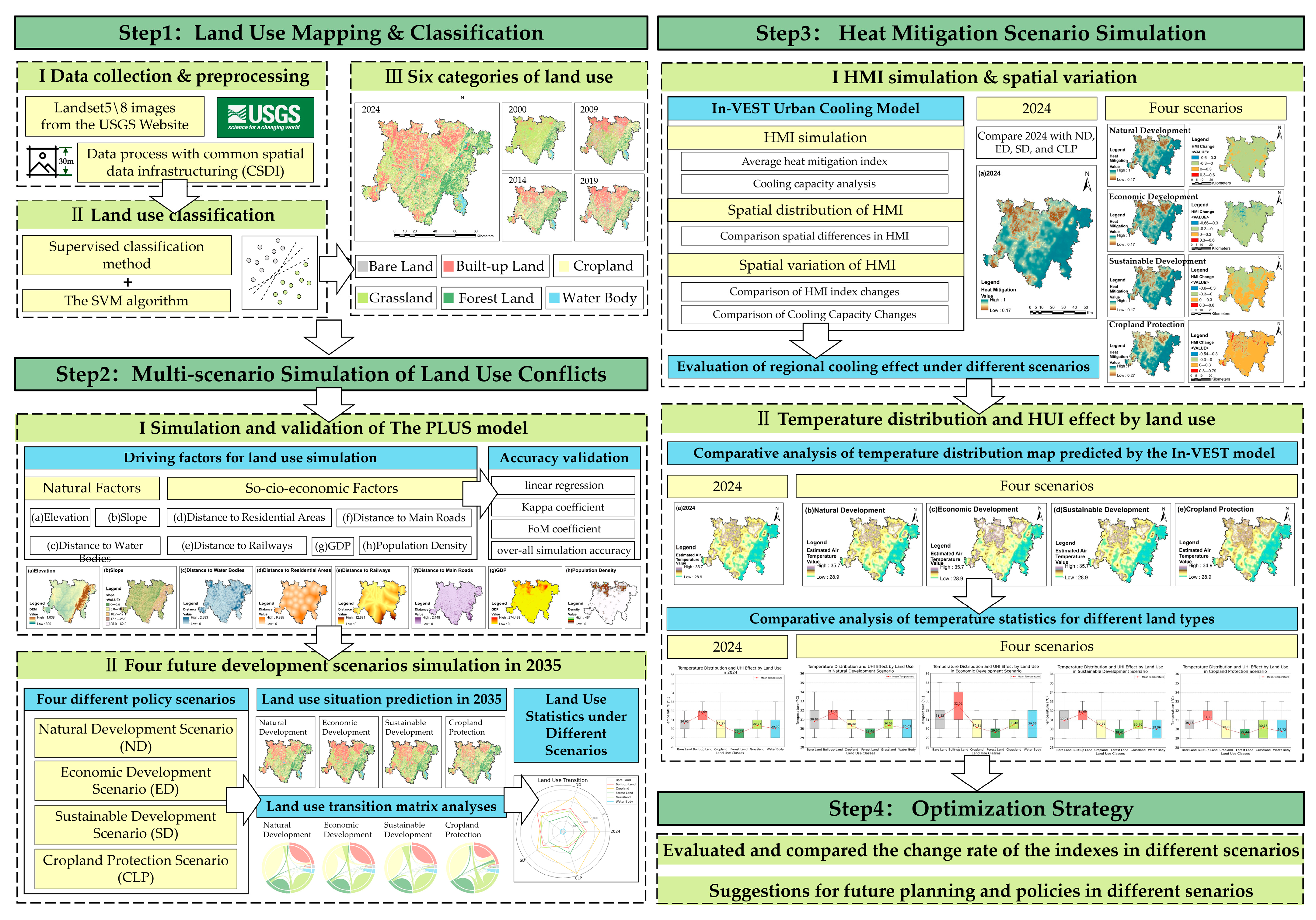
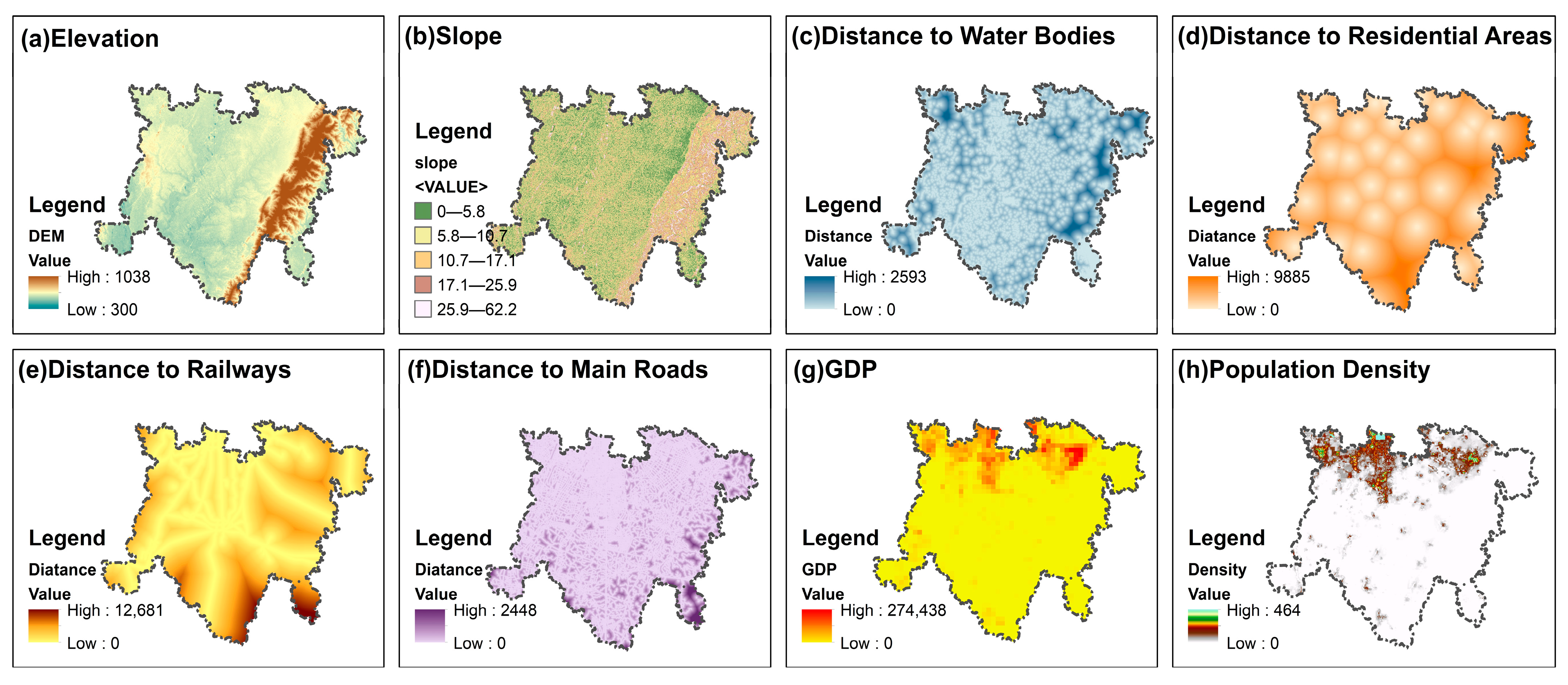
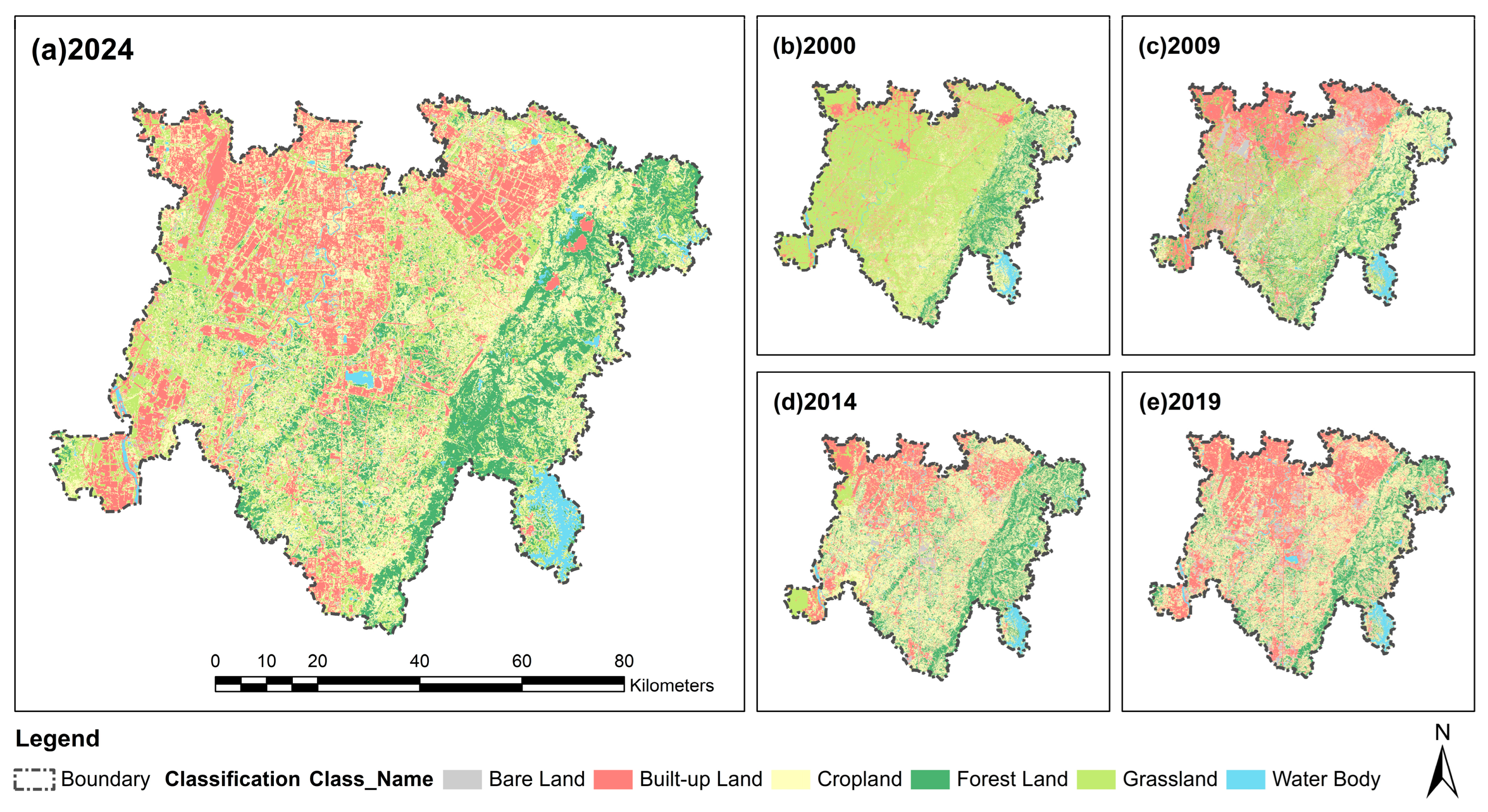
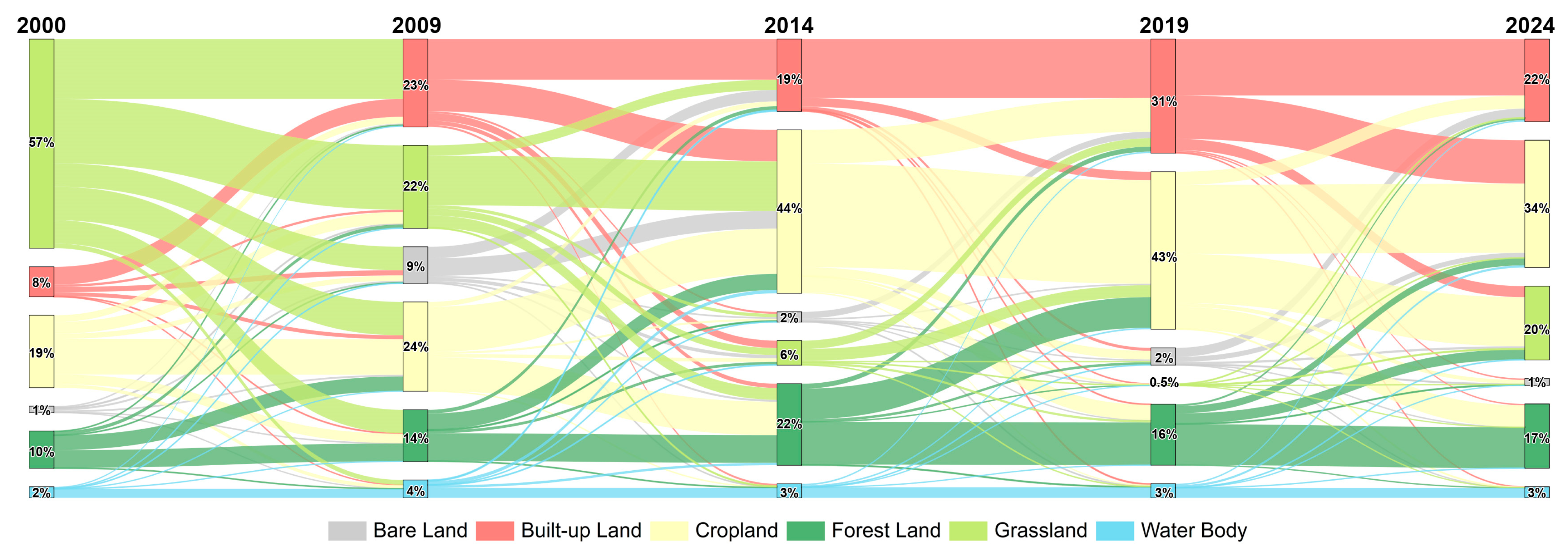

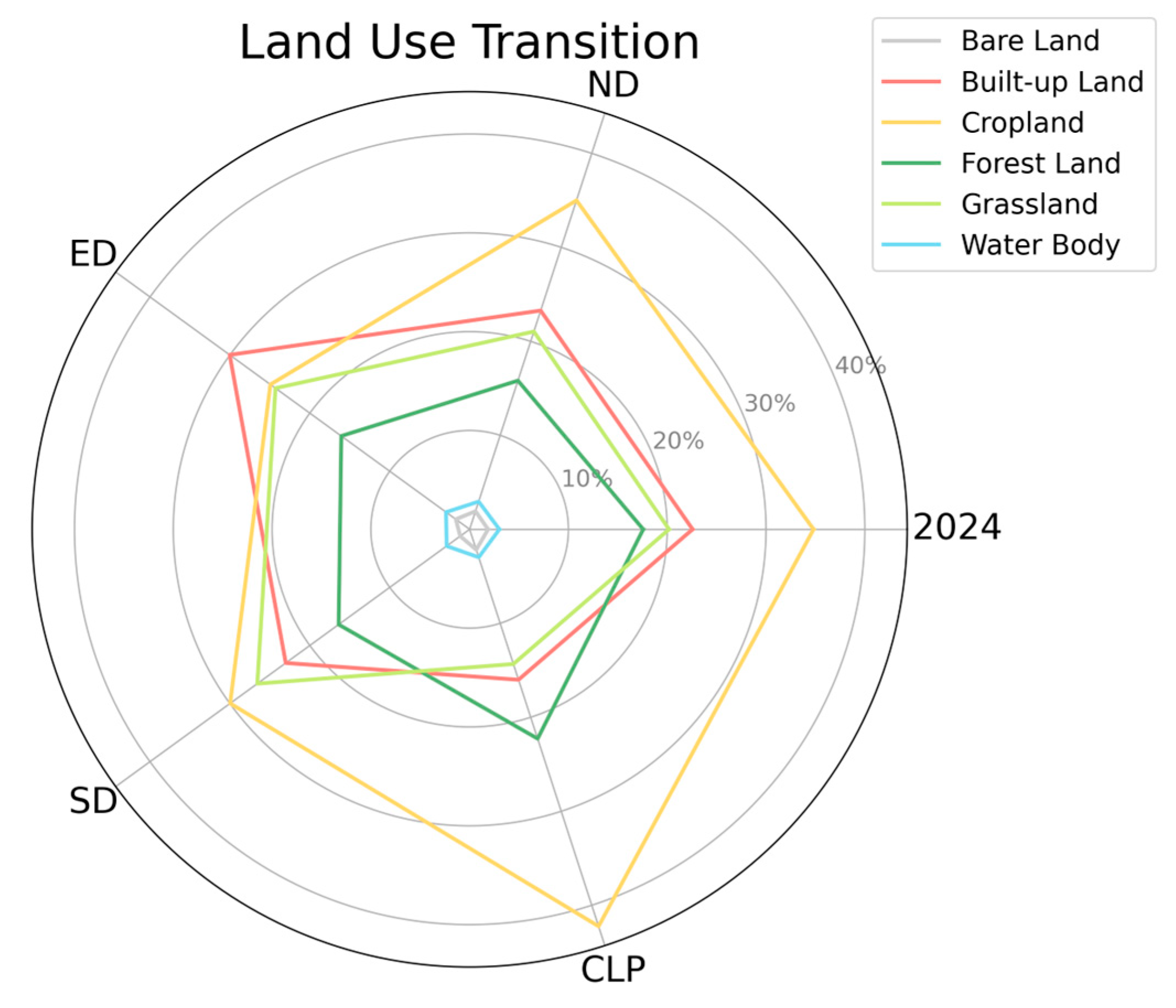
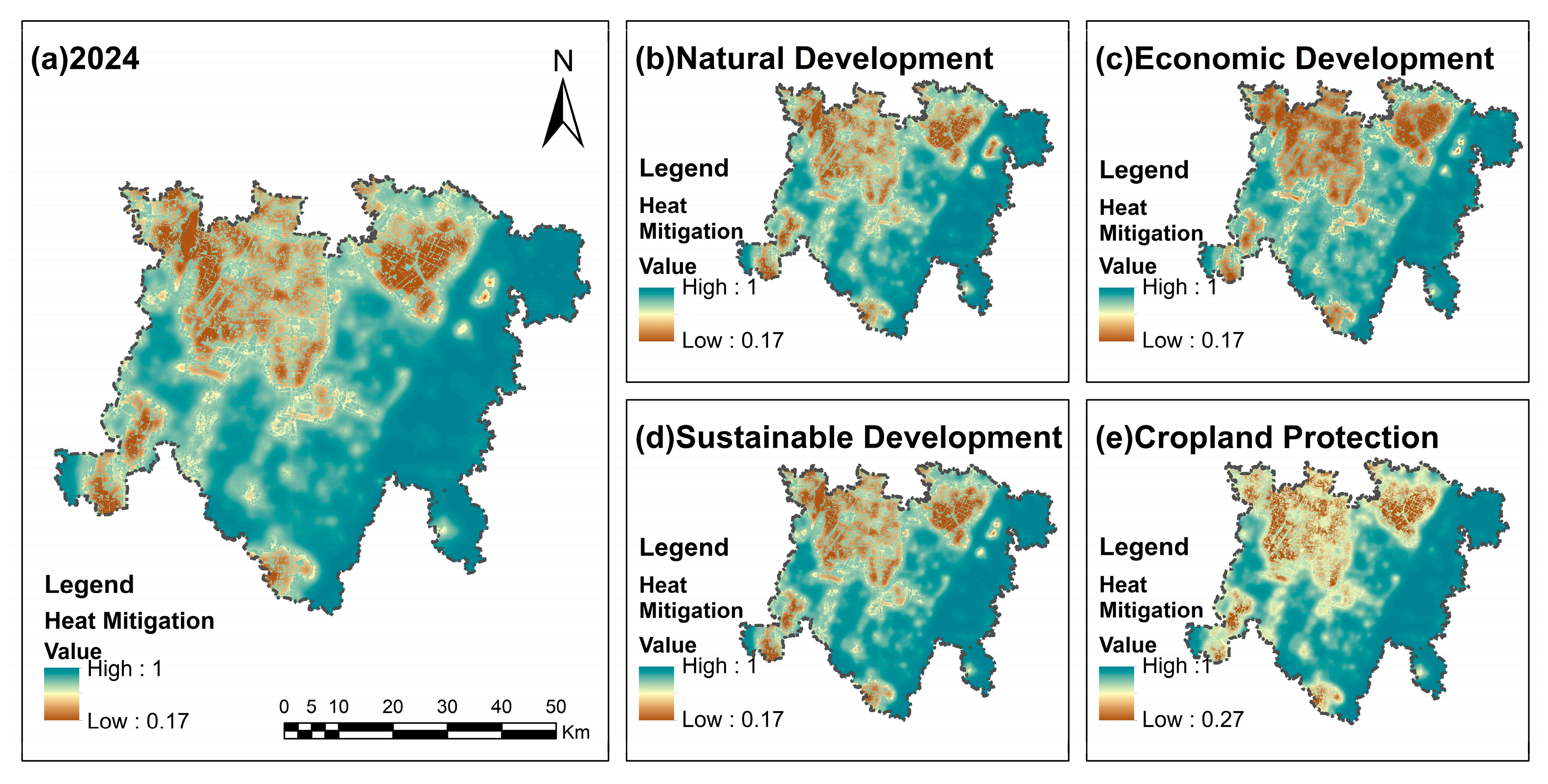
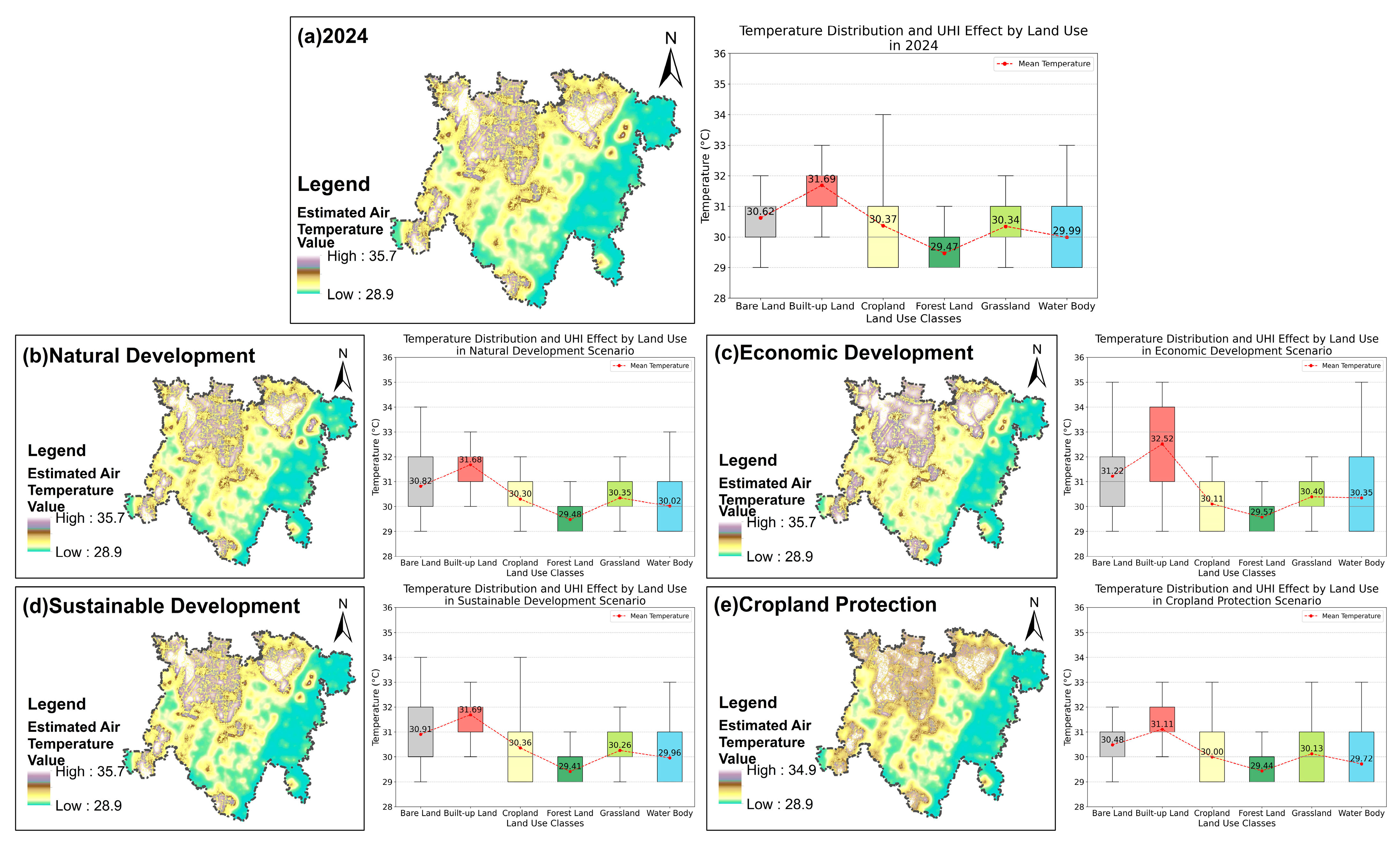
| Year | Satellite | Resolution | Band | Image Name |
|---|---|---|---|---|
| 2000 | Landsat 5 | 30 m × 30 m | Band1-7 | LT05_L1TP_129039_20000705_20200907_02_T1 |
| 2009 | Landsat 5 | 30 m × 30 m | Band1-7 | LT05_L1TP_129039_20090815_20200827_02_T1 |
| 2014 | Landsat 8 | 30 m × 30 m | Band1-11 | LC08_L1TP_129039_20140813_20200911_02_T1 |
| 2019 | Landsat 8 | 30 m × 30 m | Band1-11 | LC08_L2SP_129039_20190811_20200827_02_T1 |
| 2024 | Landsat 8 | 30 m × 30 m | Band1-11 | LC08_L1TP_129039_20240824_20240831_02_T1 |
| Land Use Type | Description |
|---|---|
| Bare Land | Non-vegetated surfaces, such as barren soil, sand, and rocks, typically devoid of vegetation or covered sparsely by vegetation. |
| Built-up Land | Areas with impervious surfaces, such as buildings, roads, and other constructed elements associated with urban or industrial activities. |
| Cropland | Areas primarily used for agricultural purposes, including cultivated lands, orchards, and areas with seasonal crops. |
| Forest Land | Areas covered by woody vegetation, such as trees and shrubs, including natural forests and planted forests. |
| Grassland | Areas dominated by herbaceous vegetation, including pastures, meadows, and natural grasslands. |
| Water Bodies | Surfaces covered by water, including rivers, lakes, reservoirs, and ponds, as well as artificially created water bodies. |
| Type | Factor | Data | Resolution | Source | Year |
|---|---|---|---|---|---|
| Natural Factors | Elevation | DEM Data | 30 m | https://www.gscloud.cn/ (accessed on 5 January 2025). | 2022 |
| Slope | |||||
| Distance to Water Bodies | Water Data | — | https://www.openstreetmap.org/ (accessed on 5 January 2025). | 2024 | |
| Socio-economic Factors | Distance to Residential Areas | Residential Area Data | — | https://www.mca.gov.cn/ (accessed on 5 January 2025). | 2023 |
| Distance to Railways | Road Data | — | https://www.openstreetmap.org/ (accessed on 5 January 2025). | 2024 | |
| Distance to Main Roads | |||||
| GDP | GDP Data | 1 km | http://www.geodata.cn/ (accessed on 5 January 2025). | 2020 | |
| Population Density | Population Density Data | 1 km | https://hub.worldpop.org/ (accessed on 5 January 2025). | 2020 |
| 0–0.2 | 0.2–0.4 | 0.4–0.6 | 0.6–0.8 | 0.8–1.0 | ||||||
|---|---|---|---|---|---|---|---|---|---|---|
| Area (km2) | Rate | Area (km2) | Rate | Area (km2) | Rate | Area (km2) | Rate | Area (km2) | Rate | |
| 2024 | 5.00 | 0.31% | 103.13 | 6.44% | 162.51 | 10.14% | 303.93 | 18.97% | 1027.95 | 64.15% |
| ND | 5.24 | 0.33% | 105.73 | 6.60% | 167.07 | 10.43% | 316.23 | 19.73% | 1008.24 | 62.92% |
| ED | 74.56 | 4.65% | 217.68 | 13.58% | 103.34 | 6.45% | 236.03 | 14.73% | 970.94 | 60.59% |
| SD | 5.76 | 0.36% | 108.93 | 6.80% | 161.33 | 10.07% | 265.32 | 16.56% | 1061.18 | 66.22% |
| CLP | 0.00 | 0.00% | 21.14 | 1.32% | 111.25 | 6.94% | 340.40 | 21.24% | 1129.74 | 70.50% |
| Policy Scenarios | Land Use Change | Ecological Impact | UHI Change |
|---|---|---|---|
| ND | Cropland decreases, built-up land increases | Cooling capacity declines | UHI intensifies |
| ED | Built-up land expands significantly, ecological land decreases | Cooling capacity drops drastically | UHI becomes the most severe |
| SD | Forest land and grassland increase | Cooling capacity improves | UHI mitigates |
| CLP | Cropland is protected, built-up land expansion is restricted | Optimal cooling capacity | UHI is minimized |
Disclaimer/Publisher’s Note: The statements, opinions and data contained in all publications are solely those of the individual author(s) and contributor(s) and not of MDPI and/or the editor(s). MDPI and/or the editor(s) disclaim responsibility for any injury to people or property resulting from any ideas, methods, instructions or products referred to in the content. |
© 2025 by the authors. Licensee MDPI, Basel, Switzerland. This article is an open access article distributed under the terms and conditions of the Creative Commons Attribution (CC BY) license (https://creativecommons.org/licenses/by/4.0/).
Share and Cite
Lin, R.; Wu, Y.; Wu, Y.; Wu, R.; Yang, J. Park City 2035: Analysis of Policy-Driven Urban Expansion and Heat Island Effects Under Scenario Simulation. Land 2025, 14, 631. https://doi.org/10.3390/land14030631
Lin R, Wu Y, Wu Y, Wu R, Yang J. Park City 2035: Analysis of Policy-Driven Urban Expansion and Heat Island Effects Under Scenario Simulation. Land. 2025; 14(3):631. https://doi.org/10.3390/land14030631
Chicago/Turabian StyleLin, Rong, Yujing Wu, Yuqiu Wu, Ran Wu, and Jing Yang. 2025. "Park City 2035: Analysis of Policy-Driven Urban Expansion and Heat Island Effects Under Scenario Simulation" Land 14, no. 3: 631. https://doi.org/10.3390/land14030631
APA StyleLin, R., Wu, Y., Wu, Y., Wu, R., & Yang, J. (2025). Park City 2035: Analysis of Policy-Driven Urban Expansion and Heat Island Effects Under Scenario Simulation. Land, 14(3), 631. https://doi.org/10.3390/land14030631






